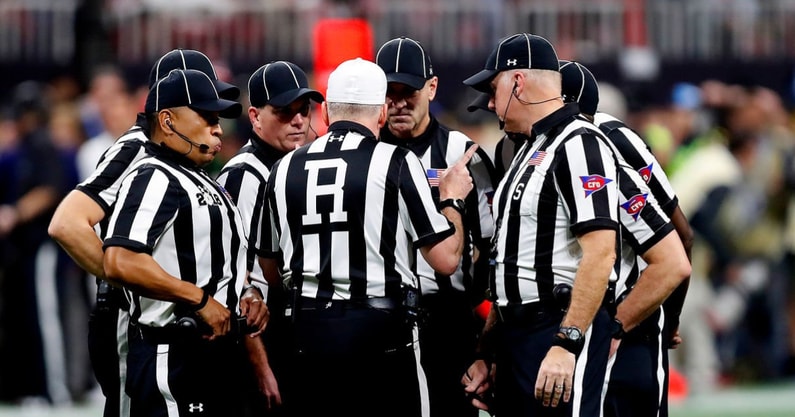Steve Shaw, national coordinator of officials, on proposed rules changes: ‘You may not even notice it in a game’

The official reason to make the changes proposed last week by the NCAA Football Rules Committee is to improve “game flow.” The unofficial reason is that in the era of up-tempo offenses, games last as long as “War and Peace” – literally. The 1956 film came in at 3:28; the average FBS game in 2022 came in at 3:27.
Any fan on a couch or in a stadium could tell you the quickest way to cut down on game length is to shorten the commercial breaks. That’s also the most expensive. Fewer commercials mean less money to the schools, and we all know that’s a non-starter. So that leaves carving time out of the game by other means. The fewer interruptions beyond the commercial breaks, the better the “game flow.”
The NCAA proposed three changes for the 2023 season, the biggest being to keep the clock running when an offense makes a first down, save for the final two minutes of each half. Another proposed rule would have penalties called on the last play of the first and third quarters no longer result in an extra play; instead, they will be enforced on the first play of the next quarter. The final proposed change would stop the use of consecutive timeouts. In this era of climate change, there now is a limit on how long you can ice the kicker.
The new rules will take effect only if the NCAA Playing Rules Oversight Committee approves at its meeting on April 20.
Stopping the clock on a first down has been one of the significant differences between college ball and the NFL. But let’s be clear – that rule was not handed down on stone tablets by Walter Camp. It wasn’t a rule until 1968, the sport’s 99th year, so we shouldn’t think of eliminating this rule as sacrilege.
Steve Shaw, the secretary/editor of the rules committee – that means he’s in charge – estimated that the new rule would shave seven plays out of a game. Today’s average game consists of about 180 plays. That’s every rush, pass, punt, field goal, kickoff and play that didn’t count because of penalty. Seven plays out of 180 is a 4 percent rate of shrinkflation. Not bad these days.
“You may not even notice it in a game,” Shaw said. “Over a season, it may make a difference.”
Especially when you consider that a majority of FBS teams play at least 13 games per season. In 1968, Division I teams played 10 games in the regular season and there were only 10 bowl games.
The 1968 rule change came about because as offenses began to move faster down the field, the chain gangs had trouble keeping up (and this was long before Chip Kelly considered it a mortal sin to let the 40-second play clock tick below 30 seconds).
The late Dave Nelson, the Hall of Fame coach at Delaware and the longtime secretary/editor of the rules committee, wrote that after passing the first-down rule for the 1968 season, the number of plays per game increased from 140 to 144. That’s a long way from 180. Shaw said the NCAA data from so long ago is incomplete; the belief is that Nelson referred to the number of plays from scrimmage – runs and passes.
“There’s no question that there are more plays now,” Shaw said.
Shaw, also the national coordinator of officials, called the changes “a measured approach.” What no one knows is what unintended consequences will come with these rule changes. The Rules Committee tried to shorten the game 15 years ago by adopting the 40-second/25-second play clock rule and by no longer stopping the clock on an out-of-bounds play until the final two minutes of a half.
Top 10
- 1Breaking
Trae Young
Hired as OU assistant GM
- 2
Zvonimir Ivisic
Re-enters Transfer Portal
- 3Hot
SEC Tampering
South Carolina accusation
- 4
Final Four refs
Officiating teams announced
- 5Trending
Nate Oats
Rumor shot down
Get the On3 Top 10 to your inbox every morning
By clicking "Subscribe to Newsletter", I agree to On3's Privacy Notice, Terms, and use of my personal information described therein.
Todd Berry, the executive director of the American Football Coaches Association, believes those rule changes spurred the advent of the no-huddle offense. “Offensive coaches were going to get their snaps back in,” Berry said.
He’s not a fan.
“The 2008 rule(s) basically became counter-productive. It created all the no-huddle offenses, which created other problems in terms of substitutions and all of those other kinds of things for defensive coaches. It created more problems than it helped solve,” Berry said.
Berry said his membership joins the rules committee in believing that the new timing rules will not cause a dramatic change in the game. He praised the committee for its decision not to ratify a proposal to keep the clock running after incomplete passes. A study of the 2022 season estimates that the incomplete pass rule would have cut another 14 plays per game.
“I would suggest if they had gone to incomplete passes – our coaches said this – all of a sudden you’d see a faster pace, more of a turbo mode,” Berry said.
That would have been noticeable, and it also would have made the college game look more like the NFL, which averages about 155 plays per game. The bosses of college football agree that their game is different than pro football. There is a diversity of scheme in college football that doesn’t exist in the NFL.
The pros use similar offensive styles, Berry said, “because of all the free agency. They felt it was easier to plug and play. Maybe we’ll have to do the same with all the transfers.”
Maybe next year. The rules committee decided to take one measured approach at a time.